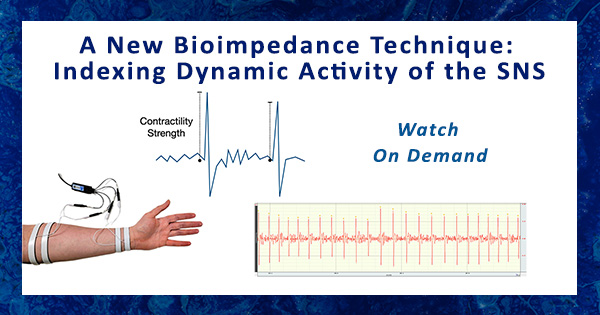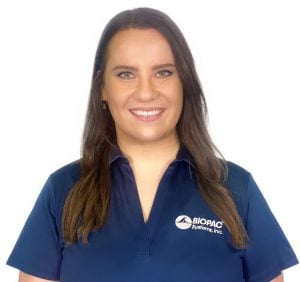A New Bioimpedance Technique: Indexing Dynamic Activity of the SNS
Date
Thursday, April 25, 2024
Location
On-Demand Playback
Host
BIOPAC SYSTEMS, INC. - U.S.A.

| Join this online seminar to learn more about Bioimpedance and more specifically, Trans-radial Electrical Bioimpedance Velocimetry (TREV). The TREV technique can record important cardiovascular data such as Contractility Index, Acceleration, Velocity, Integral of Velocity, and Cardiac Output. Researchers will describe how they have used this technology in their research projects to record the Contractility Index as a robust measure of dynamic sympathetic nervous system activity. The researchers will describe their experimental setup, data collection techniques for in lab and MRI, and analysis methodology. The TREV technique measures beat-by-beat cardiac contractility with less of the complications associated with transthoracic impedance cardiography. BIOPAC has developed special hardware to reduce setup time and complexity as well as obtain high-quality data without the subjectivity of locating the B-point (aortic valve opening time). They will discuss their use of the TREV technique and the data they collected using it. Traditional transthoracic bioimpedance uses either tape, strip, or spot electrodes placed around, or on, the sides of the torso. It takes considerable time to set up the participant and the technique is overly sensitive to upper body movement, requiring special care and instructions for participants to limit these movements. There is a trade-off between participant comfort and data quality, and this can also influence the ecological validity of the study. With transthoracic impedance cardiography, normal breathing causes changes of thoracic shape that are not accounted for in ideal models used to calculate cardiovascular measures. The heart’s venous return complicates the problem of examining sympathetic responses separately from other physiological variables. In addition, the analysis depends on locating the B-point (aortic valve opening time). This point can be difficult to identify, even when experts are involved. TREV avoids many of the transthoracic issues by placing electrodes on the forearm of the participant, minimizing setup time, and avoiding the upper body motion and ventilation issues associated with transthoracic impedance cardiography. Topics We Will Cover:
Related Products
Related Webinars | Complete Form to Watch Now |
 Frazer Findlay – CEO of BIOPAC
Frazer Findlay – CEO of BIOPAC
Frazer Findlay has more than 25 years of experience in life science data acquisition and analysis. Frazer is a well-regarded expert in the physiology monitoring industry and has facilitated workshops in the U.S., Europe, and Asia. He is familiar with a variety of software, equipment, and laboratory protocols for a wide array of signals and measurements. Frazer joined BIOPAC in 1996 as the Domestic Sales Manager and became CEO in 2008. He continues to develop and grow the business while also working with physiology measurement and biometric companies to improve the physiology monitoring industry.
 Viktoriya Babenko, PhD – Technical Support, BIOPAC
Viktoriya Babenko, PhD – Technical Support, BIOPAC
Dr. Babenko received her PhD in Cognitive Neuroscience from the University of California, Santa Barbara. During her academic career, she researched the effects of naturally fluctuating female sex hormones throughout the menstrual cycle on psychophysiological stress, behavior, and brain structure and function. Viktoriya is passionate about cutting edge research and scientific advancement and has joined BIOPAC to assist researchers in expanding their psychophysiological capabilities. In her spare time outside of the lab, she enjoys spending time with her friends and her dog “Data”.
 Elizabeth Rizor – PhD Candidate, UCSB
Elizabeth Rizor – PhD Candidate, UCSB
Elizabeth Rizor earned her B.S. in Exercise Science from the University of South Carolina Honors College, where she completed a senior thesis with Dr. Jill Stewart investigating the neural correlates of hand function post-stroke. After graduating, she worked as a research associate for Dr. Edythe London’s Laboratory of Molecular Neuroimaging at UCLA. There, she was involved with MRI and PET imaging projects aiming to reveal the effects of stimulant use disorder on brain physiology and behavior. Currently, she is a member of Dr. Scott Grafton’s Action Laboratory, where she applies advanced MRI methods with the goal of obtaining high quality structural and functional images of the human brain in populations in need of greater study.
 Neil Dundon, PhD – Associate Project Scientist, UCSB
Neil Dundon, PhD – Associate Project Scientist, UCSB
Neil Dundon is a computational neuroscientist who studies how human physiology (at both the central and peripheral level) is associated with parameters of human decision making, with specific emphasis on decisions to perform skillful motor actions. He is interested in how the integrated systems of the human body converge to make such decisions, and how the decisions integrate the subtly different feedback provided by outcomes and the proficiency of the physical performance. This line of enquiry has led him to designing novel experimental paradigms while also working with new ways to capture different types of signals—both in kinematic behavior and in multiple branches of the human nervous system.
For more information about BIOPAC events, check the BIOPAC Events Calendar or email support@biopac.com.
Stay Connected